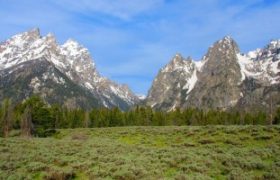“In nature nothing exists alone”
—Rachel Carson, “Silent Spring”
It’s that time of year again. School is out, summer is upon us, and road trips are like a siren’s call. Whether you’re cruising the east coast’s I-95, checking out the California coastline on Highway 1, or traversing the nation on Route 66, you’re bound to find yourself near a national park. Set your sights on communing with Mother Nature, waving to wildlife, and clicking pictures of sweeping vistas while meandering along some of the country’s most scenic drives.
Every story in America includes women. Whether it’s the mill girls of Lowell, Massachusetts, the riveters of World War II California, or the homesteaders of the Midwest, women have woven the fabric of American society. In 2012, with an edict from the Secretary of the Interior, national parks pay more attention to sharing the full American story.
You might want to begin with the Travel Channel rankings of the ten of the best spots for park activities. While each park provides a unique learning opportunity, some afford education about the land, while others provide a look at our nation’s history. Some parks also recognize, support, and celebrate gender diversity. For instance, think about visiting these:
- The Stonewall Inn (New York City) recognizes LGBT rights.
- George Washington Carver Monument (Diamond, Missouri) celebrates African American achievements.
- The Mojave Trails National Monument (Needles, California) celebrates Native American achievements.
The National Parks Service was established in 1916. When WWI created labor shortages, women were hired to temporarily replace male counterparts. Although it was a transitory situation, in 1918, Yosemite National Park welcomed Claire Marie Hodges as the first female ranger. It was 1940 when the country saw its first female national park superintendent. And it took more than six decades of determination, grit, and dedicated protest, but women finally achieved the ability to be full-fledged national park rangers.
Meanwhile, while some women serve as parks rangers, others fervently support the creation of the parks. Without these female movers and shakers, the designation of these parks would have taken a lot longer or might never have happened at all. Check out this story, or follow along below for more connections.
- Joshua Tree National Park (Twentynine Palms, California): facilitated by Minerva Hoyt
- Manzanar National Historic Site (Independence, California): facilitated by Sue Kunitomi Embrey
- Sequoia National Park (Three Rivers, California): facilitated by Susan Priscilla Thew
- Mesa Verde National Park (near Cortez, Colorado): facilitated by Virginia Donaghe McClurg
- Great Sand Dunes National Park (Mosca, Colorado): facilitated by PEO Sisterhood (aka: Philanthropic Educational Organization)
- Katahdin Woods and Waters National Monument (Patten, Maine): facilitated by Roxanne Quimby
If you’re in search of parks that recognize feminism, celebrate women’s accomplishments, and include women in the conversation, check out the following list. Although there are still only a small number dedicated to specifically showcasing women’s history, these eight national parks recognize the rights, legacy, strides and empowerment of pivotal, trailblazing women:
- Women’s Rights National Historical Park (Seneca Falls, New York): This park shares the story of the 1848 first Women’s’ Rights Convention. Here you’ll see the names of many significant activists such as Lucretia Mott and Elizabeth Cady Stanton. Focusing on the creation of the Declaration of Sentiments, human/civil rights and access for all, this park tells the story of women’s rights and shares the struggles, journey, and history of the fight that ensued.
- Harriet Tubman Underground Railroad National Monument (Church Creek, Maryland): This monument is dedicated to the woman who was a leader in the Abolitionist Movement prior to and during the Civil War. In more than a decade, she made 19 trips to the South and is credited with escorting well over 300 enslaved persons to their freedom. The abolitionist and activist who is the most renowned conductor of the Underground Railroad (a series of safe houses) also assisted federal forces, worked as a cook, and served as a nurse.
- Clara Barton National Historic Site (Glen Echo, Maryland): This site is dedicated to the founder of the American Red Cross. The first ever national historic site to be dedicated to a woman focuses on the humanitarian contributions made by Ms. Barton.
- Mary McLeod Bethune Council House National Historic Site (Washington DC): Mary McLeod Bethune founded the first headquarters of the National Council of Negro Women. The organization was designed to represent concerns both nationally and internationally of Black women. Bethune was also the Advisor of Minority Affairs in Franklin Delano Roosevelt’s Black cabinet. As an educator and activist, through her work in schools and communities, she strove to make life better for African-Americans and used her position to be a voice for the marginalized.
- Eleanor Roosevelt National Historic Site (Hyde Park, New York): This site is the home of Eleanor Roosevelt, who lived here after the death of President Franklin Delano Roosevelt. She helped author the Universal Declaration of Human Rights, brought attention to civil and women’s rights issues, and is credited with redefining the role of First Lady.
- Rosie the Riveter-World War II Home Front National Historic Park (Richmond, California): This park recognizes the significant contributions of the approximately 18 million women who entered the industrial workforce during World War II created by the labor shortage on the home front.
- Maggie L Walker National Historic Site (Richmond, Virginia): This historic site is the home of Maggie Walker, the first African-American woman in the U.S. to found a bank. She was a dedicated civic leader who focused her efforts on civil rights, economic equality/empowerment, and educational access and opportunities for African-Americans. Her activism and perseverance left an enduring mark on both the community and the country.
- Belmont-Paul Women’s Equality National Monument (Washington DC): This national monument is the original headquarters of the National Woman’s Party. Founded by suffragist/feminist, Alice Paul, the National Woman’s Party is the party that introduced the Equal Rights Amendment and continued to fervently campaign for the equal rights for women.
Plan your journey or take a spontaneous trip. Learn as you go and teach the next generation about the national parks system and all it has to offer. Celebrate the differences, cherish the environment and empower all of us to do our part to better humanity and the planet.


Leave a Reply